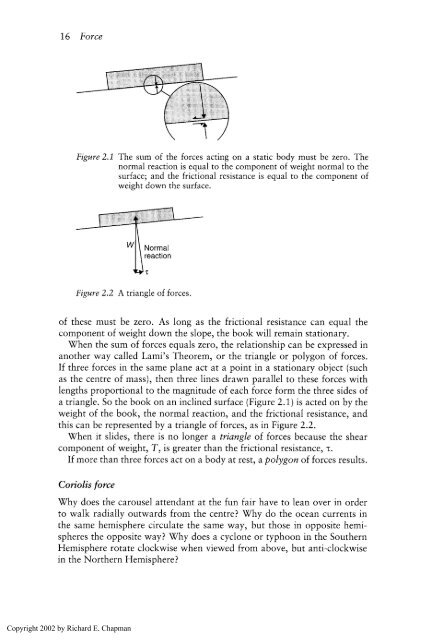Physics for Geologists, Second edition
Physics for Geologists, Second edition
Physics for Geologists, Second edition
You also want an ePaper? Increase the reach of your titles
YUMPU automatically turns print PDFs into web optimized ePapers that Google loves.
16 Force<br />
Figure 2.1 The sum of the <strong>for</strong>ces acting on a static body must be zero. The<br />
normal reaction is equal to the component of weight normal to the<br />
surface; and the frictional resistance is equal to the component of<br />
weight down the surface.<br />
Normal<br />
reaction<br />
Figure 2.2 A triangle of <strong>for</strong>ces.<br />
of these must be zero. As long as the frictional resistance can equal the<br />
component of weight down the slope, the book will remain stationary.<br />
When the sum of <strong>for</strong>ces equals zero, the relationship can be expressed in<br />
another way called Lami's Theorem, or the triangle or polygon of <strong>for</strong>ces.<br />
If three <strong>for</strong>ces in the same plane act at a point in a stationary object (such<br />
as the centre of mass), then three lines drawn parallel to these <strong>for</strong>ces with<br />
lengths proportional to the magnitude of each <strong>for</strong>ce <strong>for</strong>m the three sides of<br />
a triangle. So the book on an inclined surface (Figure 2.1) is acted on by the<br />
weight of the book, the normal reaction, and the frictional resistance, and<br />
this can be represented by a triangle of <strong>for</strong>ces, as in Figure 2.2.<br />
When it slides, there is no longer a triangle of <strong>for</strong>ces because the shear<br />
component of weight, T, is greater than the frictional resistance, t.<br />
If more than three <strong>for</strong>ces act on a body at rest, a polygon of <strong>for</strong>ces results.<br />
Coriolis <strong>for</strong>ce<br />
Why does the carousel attendant at the fun fair have to lean over in order<br />
to walk radially outwards from the centre? Why do the ocean currents in<br />
the same hemisphere circulate the same way, but those in opposite hemi-<br />
spheres the opposite way? Why does a cyclone or typhoon in the Southern<br />
Hemisphere rotate clockwise when viewed from above, but anti-clockwise<br />
in the Northern Hemisphere?<br />
Copyright 2002 by Richard E. Chapman






